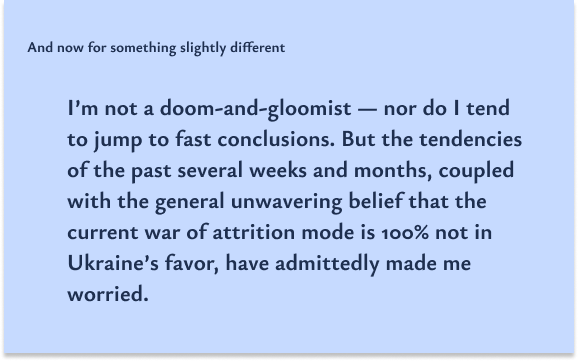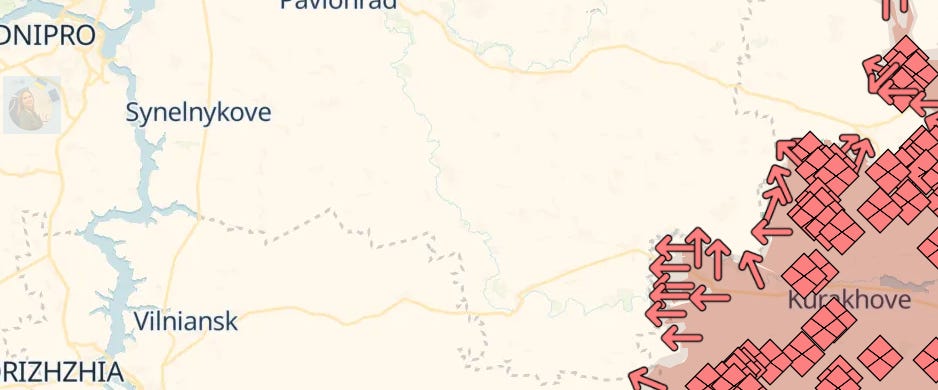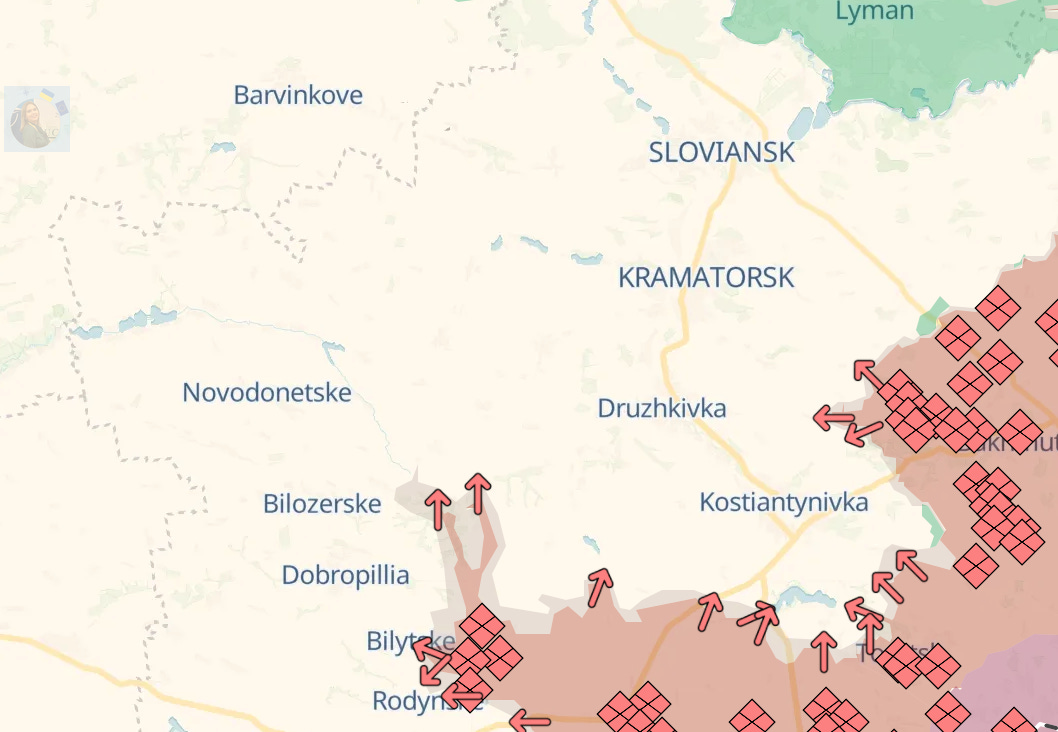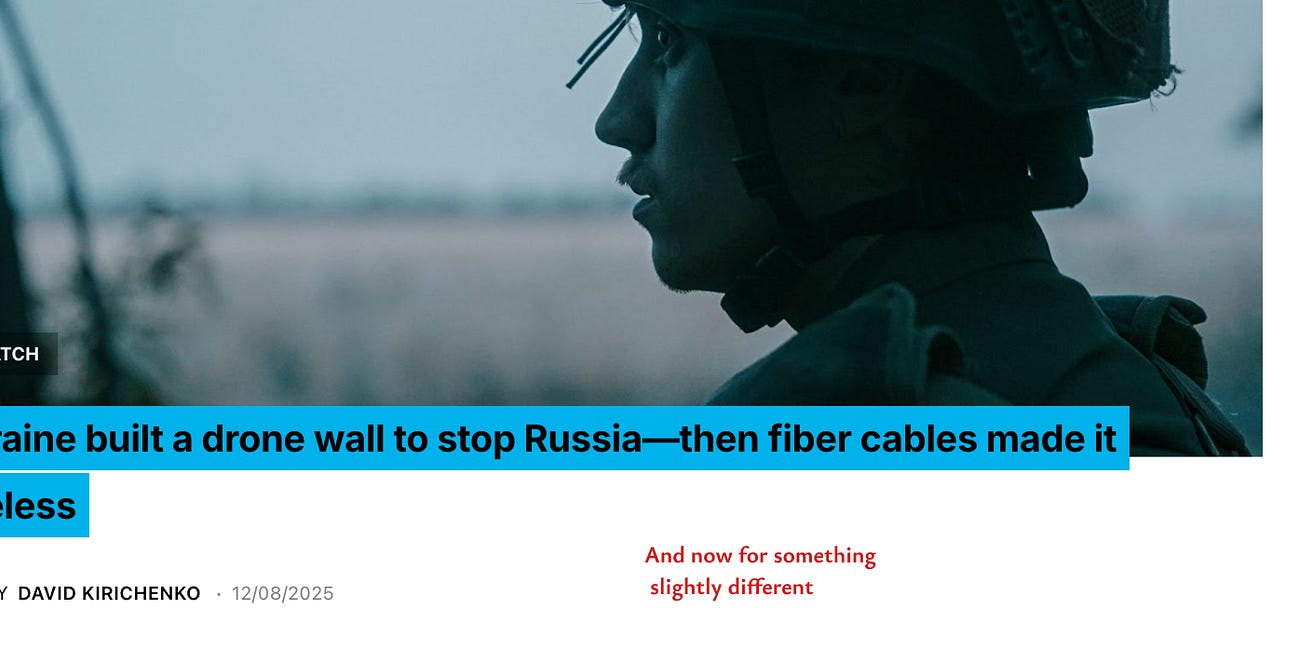Forget Alaska, Let's Talk about Donetsk Oblast
"The enemy often crawling close to our positions with no helmet, vest or weapons then beg for water and surrender," says my informant
It’s a big day today — but we won’t be talking about that.
I fleshed out my attitude toward Trump-Putin Alaska meeting last week, and nothing has changed since then.
In short, I don’t expect much, especially since Putin is reportedly planning to spend quite some time on a sci-fi history lecture akin to the one he gave Tucker Carlson. I command that. Given that Trump’s attention span is shorter than that of a goldfish, I expect this endeavor to have the exact opposite effect of the one intended. I’d even suggest that Putin couple it with a brief overview of the German classic philosophy. Should really set the mood.
What worries me much more than this meeting is not the Spartan accommodation that the Russian propagandists got in Anchorage instead of a lavish hotel in Riyad, — in fact I very much welcome the humiliation — but the state of the Ukrainian front in Donetsk Oblast.
Foremost the fact that the front has now almost reached the Dnipro Oblast, and I see absolutely no reason to not be worried about it. Dnipro Oblast like Donetsk Oblast has important resource pools, which Russia has been very much busy conquering in Ukraine. After all, don’t forget that one of the many reasons why Russia is so keen on the Donbas region is because it is a wealthy place resource-wise, not because they care about the “plight” of Russian-speakers.
The sudden moves next to Dobpropillia only serve to enhance my anxiety, and I believe that the map below is self-illustrative as to why: the two remaining big cities, Kramatorsk and Sloviansk, are at great risk.
This situation prompted me to reach out to one of my contacts on the front whom I fully trust to discuss what’s going on, asking the bold yet necessary question “Is the front on the verge of collapse?”
But before we proceed to the answer I got, I’ll remind you that I live as I preach. Not perfectly but still. So, I won’t be disclosing any sensitive information with regard to the Ukrainian tactics, positions or anything that would in any way be of use to the Russians or other malignant actors. Why you can read in my article below.
Loose Lips Sink Not Just Ships
"Here's how Mossad recruits its agents: a step by step guide to what works, and doesn’t” by Aaron Schwarzman for Israeli Epoch.
Here’s how our conversation went. I asked the following question: “Hey there! All good with you? Wanted to ask you if you know what the situation is like in Donbas right now? Is the front on the verge of collapse?”
The answer was not exactly straightforward. Instead, my contact said that the Russians continue to use their resource very ineffectively and have absolutely no regard for the lives of their own men:
“The enemy often crawling close to our positions with no helmet, vest or weapons then beg for water and surrender. What’s happing is they send out small teams (2-4). They start on motorcycles or electric bikes. They get hit by our drones or artillery. They hid in the forest or tree lines for weeks. We hear them on the radio begging their command for resupply. They never get resupply. Eventually, they give up. If they try to go back, they die. If they go forward, they most likely die. If they make it close to one of our positions alive, they are totally exhausted.”
The Russians also have a clear priority: Pokrovsk.
“I understand Pokrovsk area gets hit with a huge amount of various ordinances (FABs, artillery, drones, others) 24/7. Where there has been breakouts or advances, the enemy takes huge losses.”
I, however, pushed a bit further and asked, “how would you assess the state of the front on a scale from 1-10?” and here’s the response:
“It’s a 1,200km front. It’s depends on the sector. As I mentioned, then enemy’s focus is Pokrovsk. They put maximum effort there. But the cost in terms of men and resources is huge for the enemy.”
While he clearly avoided talking about the Ukrainian losses in comparison, perhaps, the most promising part of our dialogue is this:
“We are constantly reinforcing our positions. The Pidars (bad word for Russians;)) shell with artillery and drone dropped explosives constantly. We also get FABs. They also hit our CPs and safehouses. They use a lot of resources but haven’t achieved any large advance.”
But the not to promising one is this:
Lastly, we are constantly told that the enemy is assembling men and materiel for large scale offensive operations. I was told by an officer that the AFU has been very effective at smashing the enemy logistics in their rear areas. We are told eventually large scale attacks will come.
The Grand Conclusion
Only there’s none.
It’s evident that the situation is difficult, and that against all odds, Ukraine is standing. That’s the good news since I don’t place high hopes on Trump succeeding to secure any peace: Russia simply doesn’t need a ceasefire. So, we need the front to hold.
The keyword, however, is hold. Regrettably, I see no indicators of Ukraine being able to stabilise, let alone launch large-scale counteroffensives of some sort.
But perhaps the thing that worries me the most is this: In 2020, I went on a tour in Kyiv Oblast where visited a WWII memorial located atop of a hill. It was a pretty impressive sight, and the view of the Dnipro river was lovely. It was a sunny day after all, and very hot too. Our guide, a young man in his 20s, did his job very well and told our group, which had been tipsy by then with one elderly man complaining about the route that driver took since he knew “a better one”, to gather around and take a good look at the other bank.
“Now, I want to tell you a war story so focus. When the Red Army was nearing Kyiv in 1943, one of the main tasks was to cross the river. You’re standing here so imagine the advantage that the Nazis had. They’d see those boats crossing in an instant and kill them. Yet, the Red Army continued doing the same, and eventually they managed to accomplish their goal. At a huge price but nonetheless,” he recounted quietly.
Somehow I keep thinking about this story to this day.








Your story at the end is good, regards 1943 and the Soviet advance that eventually took them beyond Ukraine itself and all the way to Berlin.
The Soviets did indeed have massive man and material resources that dwarfed those of Nazi Germany. By simply grit and taking horrendous casualties they forced the crossing.
However, this is 2025 and Russia is not the USSR of 1943. They do not have the same men and material resources, or even the same incentives (Russian soldiers are there for the money), they don't have lend-lease (North Korea and Iran are poor allies), they don't even have the armoured vehicles for a rapid advance and exploitation (advancing on electric scooters isn't a good look)
And more importantly, Nazi Germanies allies were few. Ukraine has Europe and whilst as frustrating provision has been, they are still being actively supported.
Yes it looks dangerous on a map and it's not easy for the troops on the front. But the Russian's can advance only so far, then catchup logistics fail. Ukraine, for all it's manpower shortages, can shift it's troops with greater speed and hit Russian advances, whilst still being better supported logistically.
Plus, if it were me, I'm looking at that thin sliver of an advance and thinking "flank them, cut them off, and they're done". Advance contained.
It's scary looking, but it's not the end, not even close.
“no helmet, vest or weapons then beg for water and surrender.”
Good, if this is the case, I bet the Russia will surrender soon. Ukraine doesn’t need weapons and money anymore, they won.
Oh right, the Russians are winning? Exactly, this article is one large piece of bad propaganda.